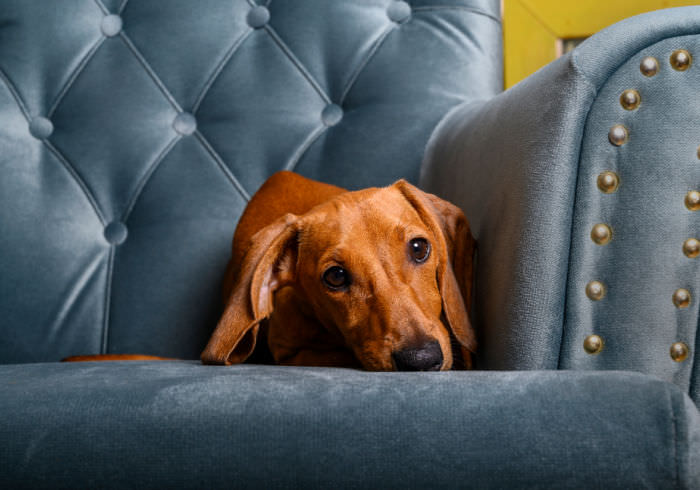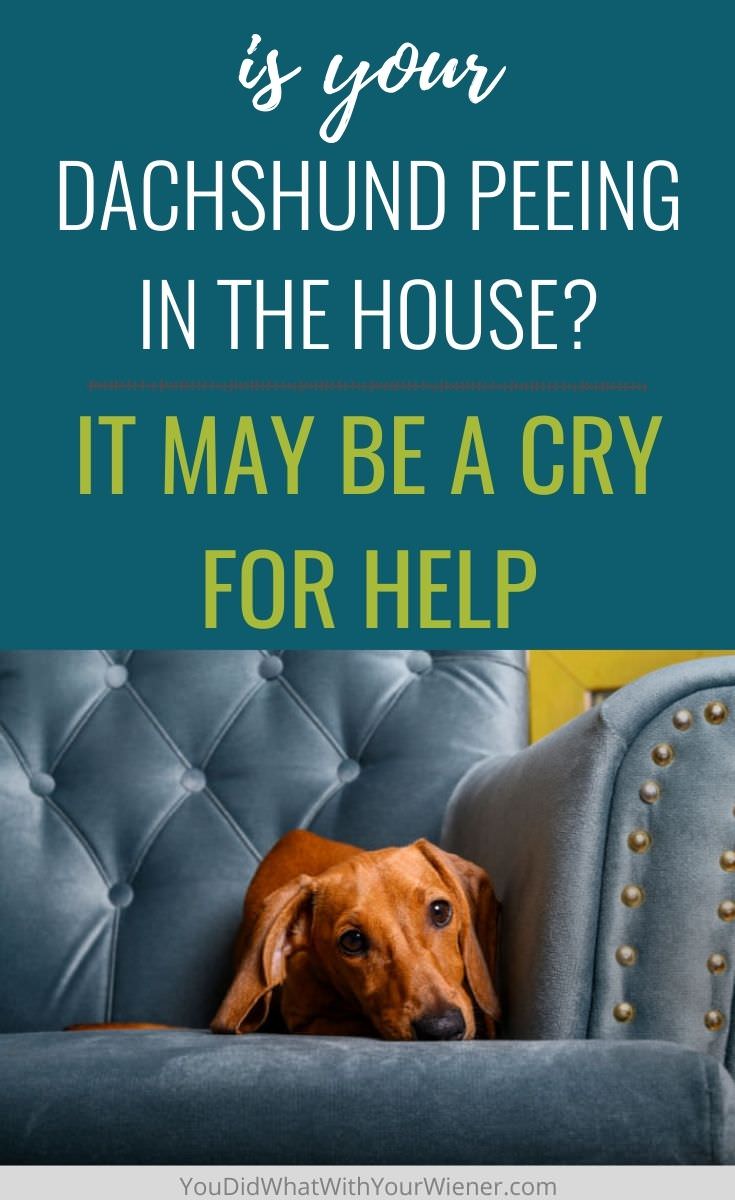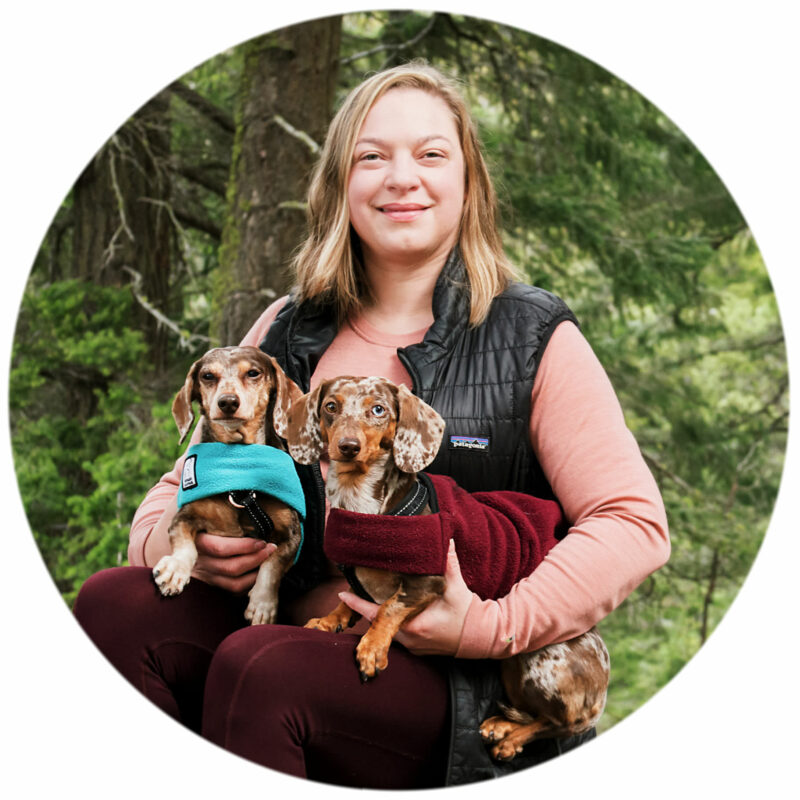Dachshund Peeing in the House? It Might Be Separation Anxiety
If your Dachshund is peeing in the house, you might think your dog needs more potty training.
But do you know that your Dachshund may not be peeing in the house for the reason you think?
I’ve seen a significant uptick of people posting in Dachshund Facebook groups about their dogs peeing on the rug, on the couch, on the bed, or some other place in the house.
UPDATED: January 17, 2023

The owners are especially frustrated because, in a lot of cases, they just took their Dachshund outside, their dog went potty, but their Doxie still peed in the house as soon as they left.
These people posting in Dachshund forums are looking for potty training advice.
While this may indeed be a potty training issue, in over half of the cases I see it is most likely not.
In a many of these cases, the person’s Dachshund pees on the floor or furniture as soon as they leave a room or walk out the door, the cause is likely separation anxiety.
If this describes what your Dachshund is doing, read on for more information.
My Dachshund Chester’s Story
This exact scenario happened to me with my first Dachshund Chester and it made me steaming mad.
I would take him outside before I left for work and he would both poop and pee.
When I left the apartment, I would come back to find a big pee spot by the door.
Naturally, I thought he had to pee and just couldn’t hold it anymore.
Or he didn’t know he was supposed to – a result of incomplete potty training.
So I committed to increasing my potty training efforts.
I read several books (the internet wasn’t a good info source for dog potty training advice back then) and tried all the tips.
My efforts to potty train my Dachshund weren’t working so I started to look for other possible reasons he was peeing on the rug.
But he continued to pee on the rug.
Then I started to notice it didn’t matter how long I was gone.
My apartment had a communal laundry room so I had to leave for a couple minutes to wash my clothes.
I would take him out to go potty right before I ran out the door for a minute in hopes of eliminating the natural need to go from the potential cause list.
I would return to still find a pee spot right inside the door.
I kept reading more because all of the potty training in the world wasn’t preventing him from peeing on the floor.
Then I discovered somethin g called separation anxiety.
What is Separation Anxiety in Dachshunds?
Separation anxiety is a type of anxiety that overcomes a dog when they are separated from their owners, the people they are attached to, even for a moment.
The trigger is the separation, not the length of time.
Separation anxiety in dogs can occur even when you are gone for “just a minute”.
It can escalate the longer you are gone – your Dachshund gets more and more upset – but your dog may act out because of this anxiety the moment you leave the room.
Doxies with separation anxiety may try to tell you they are upset by:
- Barking and howling
- Chewing things they are not supposed to
- Digging, including trying to dig a hole in the carpet or under a door
- Ruining walls or furniture
- Peeing in the house
When I see people posting pleas for help because their Dachshund is peeing in the house, and the behavior is associated with the owner leaving the room or house, the separation anxiety red flag always goes off in my head.
While there are several different reasons and triggers that could be causing your Dachshund to pee in the house, if coupled with an owner’s absence, it’s almost always separation anxiety.
So what can a Dachshund owner do to treat separation anxiety in their dog?
How I Stopped My Dachshund from Peeing in the House Due to Separation Anxiety
I was able to prevent my Dachshund from peeing in the house due to separation anxiety.
The #1 thing that prevented potty accidents and destruction due to separation anxiety was training my Dachshund to be comfortable in a dog crate.
I was able to find a solution to my Dachshund’s separation anxiety through trial and error instead of training.
When I left the house, even for a minute, I put Chester in his crate.
The theory is that a dog won’t go potty where they sleep and, in Chester’s case, this was true.
Putting him in the crate meant no accidents on the floor to clean up or accidents in the crate.
Now, a dog crate won’t solve the root cause – the separation anxiety – but the comfort of the dog crate is enough for some dogs to lessen it so they aren’t stressed out when you leave.
That was not the case with my second Dachshund Gretel who also had separation anxiety though.
Her separation anxiety was more severe than Chester’s.
In Gretel’s case, I tried putting her in a dog crate like Chester when I left the house since to keep her from peeing on the floor but she freaked out.
Even though the rescue said she was crate trained, she destroyed 2, and hurt herself more than once, trying do dig her way out.
I had almost given up but then tried what I did with Chester – use a crate that is technically one size to big for her and use an open-wire crate so she could easily see her surroundings.
The other thing that really helped was giving the dogs a stuffed treat toy when I left the house and leaving the radio on for some background noise.
Gretel was so engrossed in getting the food out, she barely noticed me leaving the house at all.
Perhaps by the time she finished, they forgot that I left or were mentally tired to the point that it no loner upset them.
Next Step: Separation Anxiety Training
In order to minimize or eliminate separation anxiety altogether in your Dachshund, you will need to train and desensitize them.
You need to teach your Doxie that there is nothing to worry about when you are gone, or at least that nothing terrible will happen.
You want to teach him or her to enjoy, or at least tolerate, being left alone for both short and long periods.
This is accomplished by separating your Dachshund from you starting with short periods when you are still near and progressing to more.
For example, start by putting your Dachshund in a dog playpen, a dog crate, or using a dog gate to block them in a room, and then go into the other room for a minute (literally).
Return to where your Dachshund is and, if they remained quiet and calm, praise your dog and give them a treat.
Gradually spend longer and longer away from your Dachshund (still inside the house).
Once your Dachshund can be left alone for at least 5 minutes, you can graduate to leaving the house.
At first, you will put your Dachshund in the same spot you did before and merely walk out the door.
You will start this training by closing the door for a few seconds, and walking back in to praise your dog if they are calm.
Eventually, you should be able to leave your Dachshund for longer and longer, with the ultimate goal of driving away and spending an extended time away from the house.
The foundation of separation anxiety is almost always desensitization training, although the instructions for doing that can vary by dog trainer.
Also, this simple desensitization exercise (and maybe trying what worked for my Dachshunds) may not work for all dogs.
Dog Separation Anxiety Resources
I’ve learned a lot about separation anxiety over the years, but I’m not a dog trainer so I can’t accurately explain more advanced separation anxiety training methods.
For that, I suggest checking out the book Be Right Back!: The frustrated dog owner’s guide to understanding and overcoming separation anxiety by pro-trainer Julie Naismith.
In Be Right Back!, certified dog trainer Julie Naismith outlines a series of training exercises that will help steer you and your four-legged friend toward independence.
Naismith uses a proven, evidence-based approach and outlines a step-by-step program that lets you gently move your dog from a place of fear to a brave new world of happy home alone confidence.
Naismith also runs a Facebook group and provides additional separation anxiety training tips there.
Some other helpful resources include:
Article: Why Does My Dog Bark or Pee On the Floor When I Leave?
This is a brief overview of separation anxiety training and recommendations for products that may help your dog right now, even before you start any training.
Article: How to Stop Your Dachshund From Barking, Scratching and Peeing When You Leave the House
In this article, Tracy Krulik, CTC, CSAT, a Certified canine separation anxiety trainer, explains her recommended technique to cure separation anxiety in dogs.
Dog separation training advice is easy to find online and there are many books out there written about the topic.
Final Thoughts
I know it can be frustrating when your Dachshund pees in the house or is destructive when you are not right there with them.
I mean, you have a life, right? You have to go to work, run errands, and visit friends and family, all which take you away from the house.
The first step in resolving any issues, and giving you freedom to leave the house again without worry, it to identify why your Dachshund is behaving this way.
Once I realized the issue with Chester was one of separation anxiety, not poor potty training, both of our lives became less stressful.
Honestly, proper separation anxiety training is not a quick process.
The number of training steps may feel overwhelming, it may be frustrating because the “fix” doesn’t happen overnight, or you may feel like you don’t possibly have the time.
But please don’t give up on your dog.
By peeing in the house, barking and howling, and being destructive, your Dachshund is trying to communicate they need help from you.
They’re not doing it to be bad. They are doing it because they are really upset and feel desperate.
Anything you can do to help ease their anxiety is a step in the right direction.
The good news is, it may not take as long to teach your Dachshund to be ok alone as you think.
Also, a lot of the training can be accomplished in just 10 minutes a day.
If your Dachshund is peeing in the house and it’s not associated with your absence, or the absence of a very important person to them, the issue may indeed be general potty training.
Here are my best tips for fully potty training a Dachshund.
If your Dachshund suddenly starts peeing in the house when they hadn’t been before, it could signal a medical condition like a urinary tract infection, incontinence, or cushing’s disease.
Please see your veterinarian to rule out any medical causes if peeing in the house is a new, sudden change.
Good luck!


About the Author
Hi, I’m Jessica. I’ve been studying the Dachshund breed since 2007, owned 3 of my own, and shared in the lives of thousands of others through their owner’s stories. When I’m not sharing what I know on this blog, you can find me hiking, camping, and traveling with my adventurous wiener dogs.

I enjoyed reading your article about Chester and his separation anxiety behavior. I too had the same issue with my doxie, Molly. Molly was a rescue at 1yr old, so naturally, we thought that her peeing in the house was poor potty training by her previous owners. But, as you did, I studied the topic and also reached out to my vet and found out about doxie “separation anxiety”. Over time Molly pottied less and less often when I left, but never really overcame the problem, no matter how many hours of training and reassurance she never overcame the problem 100 percent.
Fast forward to 2020, Molly is now an elder doxie, at 15 1/2 years old. Over the past 6 months, she has become almost completely deaf. During this period we also noticed the frequency she goes potty and #2 in the house. Even with a diligent routine of taking her outside to go potty, she will come inside and within 5-10 minutes go potty and or poopoo in the house. In fact just now as I’m writing this, she went poopoo on the floor and I ran to clean it up. I’ve taken her to the vet so many times over the past 6 months to try to figure it out. She is now on meds for incontinence, however I’m finding that doesn’t seem to be the problem, due to the fact she doesn’t potty in her sleep (the true sign of incontinence). The vet now describes Molly as having doggy dementia. WIth doggy dementia apparently, Molly doesn’t realize anymore that going potty or poopoo is a no-no. I recently heard about acupuncture for dogs and that it may help?? So I made an appointment with a holistic vet in my area. She has a very busy practice so the appointment is 4 weeks from now. Until then do you have any recommendations on how to help my senior Molly with her desire to eliminate in the house?
PS: Forgot to mention I bought a playpen for my doxie to sleep in during the night (this helps eliminate her roaming during the night (and not barking to signal me as she used to that she has to go outside for potty). The playpen has helped to avoid accidents from happening on the carpet during the night.
Hi Cecile. I am sorry Molly developed dementia. Chester did eventually too and had the same problems with pottying in the house as you describe. Eventually, what saved my sanity was using “protective” products around the house and diapers. You can read more about what we did here: https://youdidwhatwithyourweiner.com/old-dog-peeing-house-help/
I have a 4 1/2 year old dachshund who has always given me trouble with peeing in the house. He goes through phases of no accidents in the house and then on the turn of a dime will go back to peeing in the house when I’m gone and on furniture when I’m in another room. I get up every morning and take him for a long walk (I work in the office 9-5) and recently he has started peeing on the carpet almost immediately after I leave but also in the evenings when I’ve been home from work for hours and he’s been out fairly recently. He’s already been checked for a UTI and everything is fine health wise, and he’s been on medication for separation anxiety for years. I’m reaching the end of my rope and don’t know what else to do. Its beyond frustrating being away from the house and knowing I will have pee or poop to clean up as soon as I walk through the door.
Hi Lindsay. I definitely understand your frustration. The behavior definitely sounds anxiety-caused to me (but I am not a vet). When you are gone, it may be because you are separated. When you are home and he does it, is it when you are busy doing other things like cooking dinner, cleaning, or doing chores? In other words, he doesn’t sneak off and do it if you are sitting with him on the couch watching TV? One sure way to make sure he doesn’t pee on the carpet when you leave is to confine him to a dog crate, pen, or block him into a room that doesn’t have carpet like the kitchen. You could also consider using a belly band so he will be reminded not to pee and if he doesn’t it won’t go on the floor. There are some other suggestions in this article I wrote about my Dachshund who developed incontinence (I know that is not your dog’s issue but many solutions are similar). https://youdidwhatwithyourweiner.com/old-dog-peeing-house-help/ Good luck.
Hi Lindsay,
Last night my son & daughter in law came for dinner and, as always, brought their 2 yr. old long haired mini dachshund, Lars, with them. Lars has a really hard time settling down in general. He was chewing on a stuffed animal and I began to see that the little eyes were starting to rip out and was afraid he might swallow them. BTW, he had just been outside and urinated. I took the stuffed animal away and put it in a closet. I saw him walk into the bedroom and followed him in. He had dribbled urine on the carpet. He looked at me and ran away. So he knew this was a no no. I love him coming over but this was a toughy.
Hi Ellen. I get that situations like this are challenging. lars is not in his normal house, with his normal routine, and something he was into was taken away. Next time, maybe try trading him for something safer he can chew on like a bully stick or stuffed treat toy so he’s not left with a “negative”. Also, if you know he will walk away and dribble, make it physically impossible for him to do so by putting him on a leash so he can be watched closely or put him in a crate or pen (ideally, with the alternate thing to play with/chew on). Good luck.